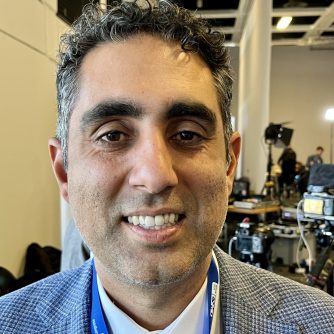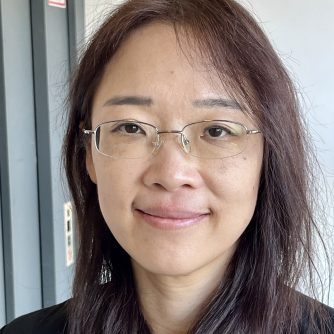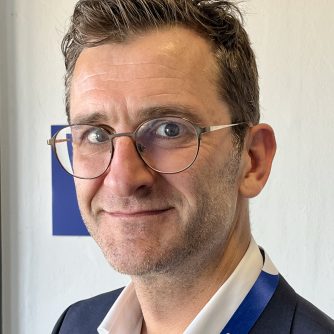
Audio Journal of Oncology interview with:
Bart Neyns MD PhD, Vrije Universiteit Brussel, Faculty of Medicine and Pharmacy, Medical Oncology Department, Brussels, Belgium
BARCELONA, Spain—Intracranial administration of autologous dendritic cells was combined with combination checkpoint inhibition in a phase 1 study of patients with recurrent glioblastoma that reported marked clinical responses to the European Society for Medical Oncology (ESMO) annual meeting in Barcelona.
Cells harvested from each patient were injected directly into the brain tissue resection cavity lining after surgery. Patients also received intra-cranial injections of the checkpoint inhibitor combination: nivolumab plus ipilimumab.
At the conference, Peter Goodwin discussed the research with lead author of the study, Bart Neyns MD PhD, Head of Medical Oncology at the Vrije Universiteit, Brussel, in the University Hospital Brussels Faculty of Medicine & Pharmacy, Brussels, Belgium.
Audio Journal of Oncology interview with: Bart Neyns MD PhD, Vrije Universiteit Brussel, Faculty of Medicine and Pharmacy, Medical Oncology Department, Brussels, Belgium
IN : “Patients with recurrent glioblastoma …. OUT:…from me, Peter Goodwin, goodbye 10:54 secs
SOURCE: ESMO 2024 Barcelona
ESMO Abstract 441O
- Neyns , Medical Oncology Department, Vrije Universiteit Brussel – Faculty of Medicine & Pharmacy, Brussels, Belgium
“A phase I clinical trial on the intracranial administration of autologous CD1c(BDCA-1)+/CD141(BDCA-3)+ myeloid dendritic cells (myDC) in combination with ipilimumab (IPI) and nivolumab (NIVO) in patients with recurrent high-grade glioma (rHGG)”
Reference:
CNS tumours Volume 35, Supplement 2S406-S407 September 2024Authors:
- Neyns1 ∙ I. Dirven1 ∙ L. Lescrauwaet2 ∙ M. Cammaert1 ∙ W. Geens2 ∙ X. Geeraerts1 ∙ L. Stevens1 ∙ S. Brock3 ∙ M. Kockx4 ∙ H. Everaert5 ∙ A-M. Van Binst6 ∙ S. Tuyaerts1 ∙ J. Duerinck7
1. Medical Oncology Department, Vrije Universiteit Brussel – Faculty of Medicine & Pharmacy, Brussels, Belgium
2. Neurosurgery, UZ Brussel – Universitair Ziekenhuis Brussel, Jette, Belgium
3. Pathology, UZ Brussel – Universitair Ziekenhuis Brussel, Jette, Belgium
4. Pathology Department, CellCarta, Antwerpen, Belgium
5. Nuclear Medicine, Vrije Universiteit Brussel – Faculty of Medicine & Pharmacy, Brussels, Belgium
6. Radiology Department, Vrije Universiteit Brussel – Faculty of Medicine & Pharmacy, Brussels, Belgium
7. Neurosurgery Department, Vrije Universiteit Brussel – Faculty of Medicine & Pharmacy, Brussels, Belgium
Background
Intracranial admin of NIVO and IPI following the resection of rHGG is safe and has resulted in encouraging survival (J Duerinck et al. JITC 2021). myDC play a pivotal role in initiating an adaptive anti-tumor immune response and licensing of immune anti-tumor effector cells within the tumor microenvironment.
Methods
rHGG pts (after prior RT and TMZ, <8 mg methylprednisolone QD), underwent a leukapheresis followed by isolation/cryopreservation of myDC. NIVO (10 mg IV) was administered preoperatively. myDC (5-, 10-, or 20.106 cells) were injected into the brain tissue lining the resection cavity (iCer) following a maximal safe resection (MSR) or intratumorally (iTum) following a stereotactic biopsy (STX). IPI (5 mg) plus NIVO (10 mg) were co-injected iCer or iTum with the myDC. Postoperative NIVO was administered intracavitary (iCav, 10 mg) and intravenously (IV, 10 mg) Q2w (max 11x).
Results
21 pts (13 M; med 49 y [range 20 -78]; IDHwt 17 pts, ECOG PS 0 or 1: 18-, 3 pts) underwent procurement of myDC; intraoperative administration of myDC was preceded by MSR in 19 pts, and STx in 2 pts. Respectively 6, 3, and 12 pts were treated at the 3 myDC dose levels. All pts received the peri-op iTum/iCer/IV-admin of IPI and NIVO as planned. The median postop iCav and IV NIVO-admin was 7 (range 0-11) and 8 (0-11). Study treatment was discontinued early for PD in 9- and AE in 3 pts. Most important TRAEs: bacterial colonization of the Ommaya reservoir (n=4), craniotomy wound dehiscence (n=2), and bacterial meningitis (n=1). At DBL (01MAY2024), 6 pts (29%) remain progression-free (incl. 3 pts with >2y PFS). PFS (med. 24w [95% CI 8- 39]) is superior when compared to the pts (n=70) with resectable rHGG treated in 4 other cohorts of the GlITIpNi trial (p=0.003). When including the durable benefit from bevacizumab at first PD in 3 pts, PFS compared favorably to a historical pooled cohort (n=469) of rHGG treated with VEGF(R)-inhibitors (p=0.007). The 1-year OS-rate was 50% [95% CI 24-76].
Conclusions
Intracranial administration of myDC combined with IPI/NIVO is feasible, safe and associated with encouraging survival, deserving further investigation.








